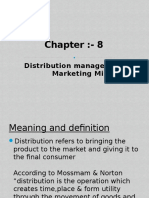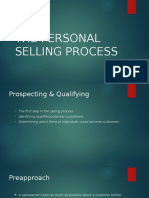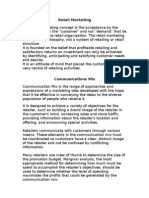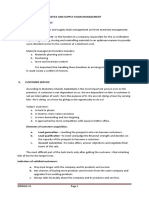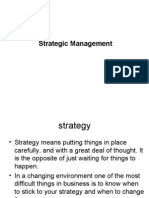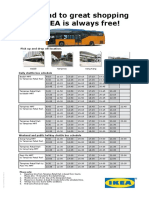0 ratings0% found this document useful (0 votes)
306 viewsStore Layout and Visual Merchandising
This document discusses store layout and visual merchandising strategies. It outlines objectives like implementing business strategy, building loyalty, and controlling costs. It also discusses design trade-offs between stimulating sales versus ease of shopping. Key elements covered include store layouts like grid, racetrack, and free-form; signage; feature areas; fixtures; and presentation techniques. It emphasizes that store atmosphere should be tailored to customers' shopping goals, with task-focused stores having simpler designs than entertainment-focused stores. Web site design priorities of simplicity, easy navigation, and blending with physical stores are also outlined.
Uploaded by
Sagar BhardwajCopyright
© © All Rights Reserved
Available Formats
Download as PPTX, PDF, TXT or read online on Scribd
0 ratings0% found this document useful (0 votes)
306 viewsStore Layout and Visual Merchandising
This document discusses store layout and visual merchandising strategies. It outlines objectives like implementing business strategy, building loyalty, and controlling costs. It also discusses design trade-offs between stimulating sales versus ease of shopping. Key elements covered include store layouts like grid, racetrack, and free-form; signage; feature areas; fixtures; and presentation techniques. It emphasizes that store atmosphere should be tailored to customers' shopping goals, with task-focused stores having simpler designs than entertainment-focused stores. Web site design priorities of simplicity, easy navigation, and blending with physical stores are also outlined.
Uploaded by
Sagar BhardwajCopyright
© © All Rights Reserved
Available Formats
Download as PPTX, PDF, TXT or read online on Scribd
You are on page 1/ 16
Store Layout and Visual Merchandising
• Submitted To: • Submitted BY:
Dr. G.N Shrivastav Sagar Bhardwaj
Rishabh Shukla
Saurav Pun
Sharookh
Ritesh Singh
Store Design Objectives
Implement Retailer’s strategy
Build Loyalty
Increase Sales on Visits
Control Cost
LegalConsiderations
Design Trade-Offs
• stimulating impulse purchases
• making it easy to find merchandise
• making it easy tobuy products
• providing an interesting shopping experience
is determined by the customer’s shopping needs
• productively using this scarce resource for
merchandise
• giving customers adequate space in which to
shop
• Store Design Elements
• Layouts
• Signage and Graphics
• FeatureArea
• GridLayout
• Grid layout has parallel aisles
with merchandise on shelves on
both side of the aisles
• Cash registers are located at the
• entrances/exits of the stores
• Easy to locatemerchandise
• Cost-efficient
• Most supermarkets and full-line
• discount stores use the grid
layout
• Limitation
• Does not encourage customers
to explore store
• Racetrack Layout(Loop)
• Loop with a major aisle
that has access to
departments
• Draws customers
around the store
• Provide different viewing
angles and encourage
exploration, impulse
buying
• Used in department stores
• Free-FromLayout
• Fixtures and aisles
arranged asymmetrically
• Provides an intimate,
relaxing environment that
facilitates shopping and
browsing
• Category Signage
identifies types of products
and located near the goods
• Promotional Signage
relates to specific offers –
sometimes in windows
• Point-of-sale Signage
near merchandise with
prices and product
information
• Featureareas
• Areas within a store designed
to get thecustomers’ attention
• Feature areas
– Windows
– Entrances
– Freestanding displays
– End caps
– Promotional aisles
– Walls
– Dressing rooms
– Cash wraps (POP
counters, checkout
areas)
• VisualMerchandising
• Fixtures
A. Straight rack
B. Rounder (bulk fixture,
capacity fixture)
C. Four-way fixture (feature
fixture)
D. Gondolas
• VisualMerchandising
• Presentation
Techniques
• Idea-Oriented Presentation
• Item and size Presentation
• Color Organization
• Price Lining
• Vertical Merchandising
• Tonnage Merchandising
• Frontal Presentation
• Creatin an Appealing
StoreAtmosphere
Lighting
Color
Music
Scent
How Exciting Should a StoreBe?
Depends on the Customer’s
Shopping Goals
– Task-completion:
• a simple atmosphere with
slow music, dimmer
lighting, and blue/green
colors
– Fun:
• an exciting atmosphere
with fast music, bright
lightning.
Web SiteDesign
• Simplicity Matters
• Getting Around –Easy Navigation
• Let Them SeeIt
• Blend the Web Sitewith the Store
• Prioritize
Web SiteDesign
• Type of Layout
– When shopping on the Web, customer are
interested in speed, convenience, ease of
navigation, not necessarily fancy graphics
• Checkout
– Make the process clear and appear simple
– Enclose the checkout process
– Make the process navigable without
lossof information
– Reinforce trust in the checkoutprocess
THANK
YOU
You might also like
- Sample Complaint For Unfair Sales Practice Under The Consumer Act of The Philippines100% (1)Sample Complaint For Unfair Sales Practice Under The Consumer Act of The Philippines5 pages
- 20.integrating and Controlling The Retail Strategy100% (1)20.integrating and Controlling The Retail Strategy15 pages
- Retail Marketing Soft Copy Notes For The TestNo ratings yetRetail Marketing Soft Copy Notes For The Test7 pages
- Retail Management: Service & Quality in RetailingNo ratings yetRetail Management: Service & Quality in Retailing19 pages
- Industrial Distribution Channels Marketing Logistics100% (1)Industrial Distribution Channels Marketing Logistics13 pages
- Module - 3 MGMT of Sales Territory & Sales QuotaNo ratings yetModule - 3 MGMT of Sales Territory & Sales Quota16 pages
- Managing The Marketing Communication ProcessNo ratings yetManaging The Marketing Communication Process7 pages
- 4: Managing Marketing Information To Gain Customer InsightsNo ratings yet4: Managing Marketing Information To Gain Customer Insights12 pages
- Evolution of Franchise in India: Presented By: Ram Niwash Singh YadavNo ratings yetEvolution of Franchise in India: Presented By: Ram Niwash Singh Yadav27 pages
- UNIT-4: Functions and Importance of Marketing ChannelsNo ratings yetUNIT-4: Functions and Importance of Marketing Channels39 pages
- Evolution of Business Policy As A DisciplineNo ratings yetEvolution of Business Policy As A Discipline5 pages
- Nilgiris Is A Supermarket Chain in South India, Which IsNo ratings yetNilgiris Is A Supermarket Chain in South India, Which Is2 pages
- Participants in The Business Buying ProcessNo ratings yetParticipants in The Business Buying Process21 pages
- From Marketing Mix To Relationship MarketingNo ratings yetFrom Marketing Mix To Relationship Marketing17 pages
- Abhi - Introduction Scope and Historical Background of SCM100% (1)Abhi - Introduction Scope and Historical Background of SCM22 pages
- Chapter One: Defining Marketing For The New RealitiesNo ratings yetChapter One: Defining Marketing For The New Realities49 pages
- ENT Chapter 14 Strategies For Growth and Managing The Implications of GrowthNo ratings yetENT Chapter 14 Strategies For Growth and Managing The Implications of Growth13 pages
- The Truth About Material Wealth: Is It God’S Blessing in Disguise?From EverandThe Truth About Material Wealth: Is It God’S Blessing in Disguise?No ratings yet
- 24. Day 24 (Trigonometry 02) (51 Days 51 Marathon)No ratings yet24. Day 24 (Trigonometry 02) (51 Days 51 Marathon)52 pages
- Captain America The First Avenger Hindi Dubbed Mobile MoviesNo ratings yetCaptain America The First Avenger Hindi Dubbed Mobile Movies4 pages
- Factors Affecting Readership PreferenceNo ratings yetFactors Affecting Readership Preference20 pages
- Factors Affecting The Readership Preferences Among The ReadersNo ratings yetFactors Affecting The Readership Preferences Among The Readers1 page
- New Product Development & Product Life-Cycle Strategies (Chapter 9)No ratings yetNew Product Development & Product Life-Cycle Strategies (Chapter 9)42 pages
- Application: The Costs of Taxation: Marwa HeggyNo ratings yetApplication: The Costs of Taxation: Marwa Heggy42 pages
- COMMENTARY Achieving A Customer Orientation Using "People-Power," The "5th P"No ratings yetCOMMENTARY Achieving A Customer Orientation Using "People-Power," The "5th P"13 pages
- Sample Complaint For Unfair Sales Practice Under The Consumer Act of The PhilippinesSample Complaint For Unfair Sales Practice Under The Consumer Act of The Philippines
- 20.integrating and Controlling The Retail Strategy20.integrating and Controlling The Retail Strategy
- Industrial Distribution Channels Marketing LogisticsIndustrial Distribution Channels Marketing Logistics
- 4: Managing Marketing Information To Gain Customer Insights4: Managing Marketing Information To Gain Customer Insights
- Evolution of Franchise in India: Presented By: Ram Niwash Singh YadavEvolution of Franchise in India: Presented By: Ram Niwash Singh Yadav
- UNIT-4: Functions and Importance of Marketing ChannelsUNIT-4: Functions and Importance of Marketing Channels
- Nilgiris Is A Supermarket Chain in South India, Which IsNilgiris Is A Supermarket Chain in South India, Which Is
- Abhi - Introduction Scope and Historical Background of SCMAbhi - Introduction Scope and Historical Background of SCM
- Chapter One: Defining Marketing For The New RealitiesChapter One: Defining Marketing For The New Realities
- ENT Chapter 14 Strategies For Growth and Managing The Implications of GrowthENT Chapter 14 Strategies For Growth and Managing The Implications of Growth
- Intellectual Capital Complete Self-Assessment GuideFrom EverandIntellectual Capital Complete Self-Assessment Guide
- The Truth About Material Wealth: Is It God’S Blessing in Disguise?From EverandThe Truth About Material Wealth: Is It God’S Blessing in Disguise?
- 24. Day 24 (Trigonometry 02) (51 Days 51 Marathon)24. Day 24 (Trigonometry 02) (51 Days 51 Marathon)
- Captain America The First Avenger Hindi Dubbed Mobile MoviesCaptain America The First Avenger Hindi Dubbed Mobile Movies
- Factors Affecting The Readership Preferences Among The ReadersFactors Affecting The Readership Preferences Among The Readers
- New Product Development & Product Life-Cycle Strategies (Chapter 9)New Product Development & Product Life-Cycle Strategies (Chapter 9)
- COMMENTARY Achieving A Customer Orientation Using "People-Power," The "5th P"COMMENTARY Achieving A Customer Orientation Using "People-Power," The "5th P"



